

| This building, the old Amsterdam Stock Exchange, is the result of a competition begun in 1884. Of the 199 entries, five were chosen, among them Berlage's entry. After various delays, Berlage drew up the interior plans and later the exterior. The building, as an exchange hall, needed large rooms for commodities as well as offices and various entrances. Now called the Beurs van Berlage, it is probably Berlage's most famous work. It is located in the center of the city but unlike other public buildings erected at the end of the nineteenth century in Amsterdam (like the Rijksmuseum or the Central Station), it does not imitate Gothic or Renaissance styles. Even though the brick exterior has some connections with Romanesque architecture or the works of the American architect Henry Hobson Richardson, its
simplicity and soberness were original in its day. It was seen as strikingly modern because it was viewed as practical and rational and because it eliminated much of the ornament common in public buildings. The facade has minimal ornament or only that which to Berlage would accentuate architectural functions--like keystones or lintels. This building itself had political overtones. The small red bricks apparently symbolized strength through numbers or cooperation; thus, they suggest a kind of democracy. According to the official website, "Berlage, being a staunch socialist, believed the stock exchange trade had a short lease of life. Yet he found a smart and creative solution for this dilemma: inspired by the Italian Palazzo Pubblicos, he decided to design the new stock exchange building in such a way that it could serve as a grand communal home, a public palace, after socialism had triumphed. He therefore built a sort of symbolic city hall, a
'public palace' that could temporarily serve as a stock exchange"(official web site). | ||
Relief In Memoriam of Hendrik Petrus Berlage, made by Lambertus Zijl in 1926 |
 | |
 |
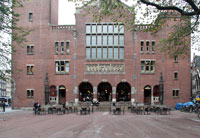 |
Short end, south side: Main entrance |
Gable with round seal of Amsterdam; decorative water spoutThe seal has a boat with a knight with sword and shield and a man with the flag of Amsterdam. See this example from Wikipedia Commons. |
 |
 |
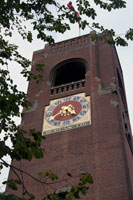 |
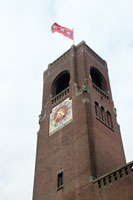 |
Asymmetry with the tall tower to the westThe clock face high on the tower reads "BEID UW TYD" ("Bide Your Time"). |
Windows on the third floor; on the second floor |
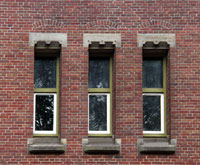 |
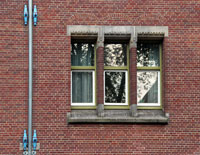 |
| Although stone sculptural decoration is limited, critics explain that Berlage believed in the idea of gesamtkunstwerk so that he worked with the poet Albert Verwey, whose poems are quoted on the facade, and the sculptor Lambertus Zijl. Berlage wanted the building and the reliefs to provide a unified message. The imagery of the Beurs shows some of the socialist ideas of the artists of the time. This sculpture above the entrance depicts on the left "Paradise," with women picking apples, in the center "the Future," and the right, "Tainted Civilization," with men lugging a beam. Underneath the relief are lines from Verwey's poem. |
||
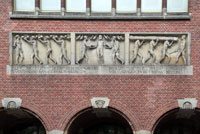 |
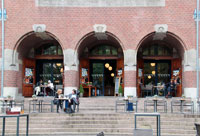 |
Central relief above main entrance; main entrance, now to a cafe |
Stone accents, here in the keystones |
||
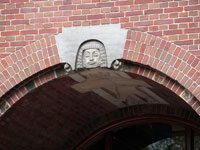 |
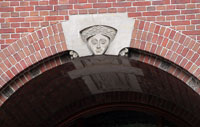 |
 |
Stone reliefs on the piers |
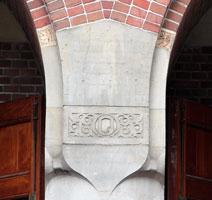 |
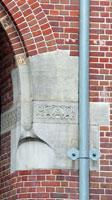 |
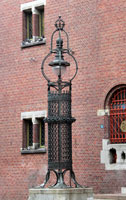 |
 |
Decorative ironwork |
| "There are three sculptures on the corners of the building of heroic figures from Amsterdam's literary and economic history; Gijsbrecht van Aemstel, a 13th century lord who was later immortalized by a play of the same name by Joost van den Vondel; Jan Pieterszoon Coen, a key figure in the Dutch East India Trading Company; and Hugo de Groot, a philosopher, theologian and jurist from the Dutch Republic who wrote Mare Liberum, an important legal doctrine that refers to the 'freedom of the seas'. By incorporating these figures into his design, Berlage juxtaposes trade with the very foundations of Amsterdam and adheres to his focus on communal function and productivity" (Stuart website). | ||
Sculpture of Gijsbrecht van Amstel by Lambertus Zijl |
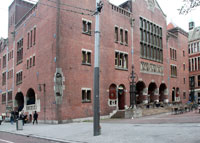 |
 |
 Click here to return to index of art historical sites.
Click here to return to index of art historical sites.
 Click here to return to index of artists and architects.
Click here to return to index of artists and architects.
 Click here to return to chronological index.
Click here to return to chronological index.
 Click here to see the home page of Bluffton University.
Click here to see the home page of Bluffton University.

